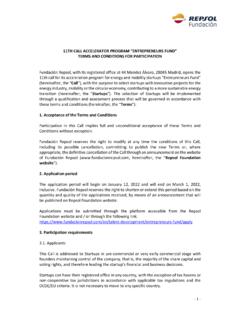Transcription of Release date : 2022-01-07
1 Release date : 2022-01-07 Version : reproduction or disclosure of this document, in whole or in part, is strictly 2022 MediaTek Inc. All rights reserved. Copyright 2022 MediaTek Inc. All rights reserved. Unauthorized reproduction or disclosure of this document, in whole or in part, is strictly prohibitedMediaTek 6G Vision01 Table of ContentsTable of Contents1 Introduction2 Timeline 2030 and beyond3 Trends and Practical Technology Principles Trend overview The Practical Technology Principles4 Wireless Access Convergence5 Distributed Network Architecture6 MIMO evolution towards True Edge-less Experience (Super-)Massive MIMO scaled to higher carrier frequency Distributed and heterogeneous MIMO architecture Main KPIs7 Towards Extreme and Predictable QOS Lean User Plane Protocol Stack Enabling extreme-throughput real-time immersive services New approach.
2 Congestion management/recovery instead of in-order delivery Cross-layer API for Dynamic Radio/Application Mutual Awareness Lean User Plane protocol stack8 System Energy Footprint and Power Efficiency Extremely power-efficient devices Network power saving Energy efficiency for extreme performance a fundamental KPI 9 Terrestrial and Non-Terrestrial Convergence Native TN/NTN integration Spectrum re-use across TN/NTN Single, affordable TN/NTN device10 Native AI-integrated System Communication and Computing Convergence 11 Spectrum More Spectrum, Better Spectrum usage Beyond 7 GHz (7-24 GHz) Sub-TeraHertz Smart spectrum access with flexible duplex Optimal spectrum sharing12 End-to-end Security Architecture Across Cloud, Network and Device 13 2022 MediaTek Inc.
3 All rights reserved. Unauthorized reproduction or disclosure of this document, in whole or in part, is strictly prohibitedMediaTek 6G of Figures and Tables Figure 1. 6G TimelineFigure 2. Observed 6G trends relative to previous cellular generationsFigure 3. Hybrid NodeFigure 4. Flexible model of data consumptionFigure 5. Key functionalities for application-driven architectureFigure 6. Example 6G Heterogeneous MIMO topology (with Centralized RAN)Figure 7. Retransmission delays across the 5G communication stackFigure 8. Cross-layer API conceptFigure 9. Big-Little device modem conceptFigure 10. Dynamic network node on/off with device-assisted wake-upFigure 11. Native TN/NTN integration and convergenceFigure 12. Spectrum re-use across TN/NTNF igure 13. Opportunities for AI integration in 6G eraTable 1. design principles: Simplexity, Optimization, ConvergenceTable 2.
4 Illustrative examples for the Simplexity principleTable 3. Illustrative examples for the Optimization principleTable 4. Illustrative examples for the Convergence principleTable 5. KPIs essential to MIMO design in 6 GTable 6. Disruption factors for extreme 6G user 7. Critical mutual awareness factors between radio layers and applicationsTable 8. Performance criteria for Lean Protocol StackTable 9. Device-power saving directionsTable 10. Potential research directions to overcome network energy footprintTable 11. Specific challenges related to power 12. Challenges and research directions for Terrestrial and Satellite convergenceTable 13. Sub-THz spectrum opportunitiesCopyright 2022 MediaTek Inc. All rights reserved. Unauthorized reproduction or disclosure of this document, in whole or in part, is strictly prohibitedMediaTek 6G Vision03 Definitions, acronyms and abbreviationsThe research community is currently in discussion regarding the exact definition of this term.
5 For the purposes of this document it refers to frequency ranges between 100 GHz and 300 GHzDefinitionsSub-GHzSub-THzFrequency bands below 1 GHzAcronyms and abbreviations3 GPP Third generation partnership projectAdv. AdvancedAF Amplify and forwardAI Artificial intelligenceAPI Application programming interfaceAPP/App ApplicationAR Augmented RealityCP-OFDM Cyclic prefix OFDMC-RAN Centralized RANDF Decode and forwardDFT-s-OFDM Direct Fourier transform spread OFDMECC Electronic communications committee (Europe)eMBB Enhanced mobile broadbandFCC Federal communications commission (USA)FDD Frequency division duplexFR Frequency RangeGEO Geosynchronous equatorial orbitIoT Internet of thingsKPI Key performance indicatorLEO Low Earth orbitLOS Line-of-sightLTE Long-term evolutionMAC Medium access control (protocol)
6 MDT Minimizing drive testsMIMO Multiple input multiple outputML Machine learningmMTC Massive MTCmmW Millimeter waveMTC Machine-type communicationsNR New radioNTN Non-terrestrial networkOFDM Orthogonal frequency division multiplexingOPEX Operational expendituresORAN Open RANC opyright 2022 MediaTek Inc. All rights reserved. Unauthorized reproduction or disclosure of this document, in whole or in part, is strictly prohibitedMediaTek 6G Vision04PA Power amplifierPAPR Peak-to-average-power ratioPDCP Packet data convergence protocolPh1, Ph2 Phase 1, Phase 2 PHY Physical layerQoE Quality of experienceQoS Quality of serviceRAN Radio access networkRel-18 3 GPP Release 18 Rel-19 3 GPP Release 19 Rel-20 3 GPP Release 20 Rel-21 3 GPP Release 21 Rel-22 3 GPP Release 22 Req RequirementRF Radio frequencyRIC RAN intelligent controllerRLC Radio link control (protocol)
7 RRH Remote Radio HeadRx ReceiverSESSy Sustainable environmental sensing systemsSON Self-optimizing networkTDD Time division duplexTN Terrestrial networkTx TransmitterUHD Ultra-high definitionURLLC Ultra-reliable and low-latency communicationsV2X Vehicle-to-everythingWRC World radiocommunications conference (Year)XR Extended realityCopyright 2022 MediaTek Inc. All rights reserved. Unauthorized reproduction or disclosure of this document, in whole or in part, is strictly prohibitedMediaTek 6G Vision051 IntroductionWith 5G availability fast expanding worldwide and a mid-generation evolution cycle anticipated in 3 GPP Release -18, now is the right time to lay down the foundations for the next generation, global 6G standard.
8 MediaTek has played a leading role in the design, standardization and ongoing evolution of 5G. It has led the way in bringing to the market mature 5G devices that can operate in new groundbreaking 5G systems ( both Radio and Core). As the world s leading smartphone chip supplier1 and an undisputed 5G commercial product leader, MediaTek is in a prime position to define and drive the vision and realization of next generation mobile technologies for was engineered and has evolved around three core sets of use cases: enhanced mobile broadband (eMBB), ultra-reliable & low-latency communications (URLLC) and massive machine-type communications (mMTC). It has been purpose-built not only to embrace the mobile broadband revolution unleashed by 4G in the consumer space, but also to enable new growth opportunities beyond this market.
9 Capitalizing on the foundations laid by 4G evolution into the cellular IoT market, 5G took a further, more significant leap to address the stringent requirements of industrial IoT. 5G has been conceived to bring the transformative power of mobile communications into every sector of our society; for the first time ever, a single communication system was designed not only to cater for a very diverse range of consumer and professional use cases in licensed and unlicensed spectrum, across sub-6 GHz and mmW bands, but also to provide connectivity beyond the traditional reach of terrestrial networks through airborne and satellite infrastructure that altogether integrates seamlessly. However, this ambitious design has translated into significant complexity for both networks and devices, leading to higher deployment costs and power consumption.
10 As a result, the 5G rollout has been incremental, focusing mostly on eMBB consumer applications , in sub-6 GHz. Achieving ubiquitous mmW coverage has been a challenge, especially from network economic perspectives. Further, while it is encouraging to see the rise of open RAN architecture coming together for 5G deployments to bring more flexibility and intelligence, the fundamental network design is still based on traditional mobile networks and layering. Significant enhancement will be expected to drive the architecture into the age of artificial intelligence and machine industry continues to evolve current 5G technology to address the aforementioned challenges, 6G technology is on the horizon to not only address these issues but also to bring fundamental transformation to mobile networks. Our 6G vision is of one global standardized technology to significantly outclass 5G and its evolution from the outset.








